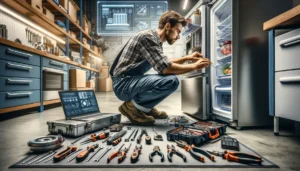It can be quite inconvenient when your washer starts having problems. In addition to the expense, it can be annoying to have to call a repair service and wait for them to arrive. DIY washer repair is an additional option, though, that a lot of homeowners are using. Fixing your washer yourself not only saves you money, but it also makes you feel good about yourself because you did it yourself. This post will discuss the advantages of doing your own washer repair, what supplies and tools you’ll need, how to troubleshoot common problems with your washer, and detailed instructions for resolving a variety of issues. It’s crucial to gather the required tools and materials before starting any do-it-yourself washer repair project. A multimeter, pliers, a set of screwdrivers, and a socket set are a few of the essential tools you’ll require. Also, your washer might require particular parts, like a new belt, pump, or motor.
Table of Contents
Key Takeaways
- DIY washer repair can be a good option for those who want to save money and time.
- Basic tools and materials needed for DIY washer repair include a screwdriver, pliers, and replacement parts.
- Troubleshooting common washer issues involves checking the power supply, water supply, and drainage system.
- Leaking washers can be caused by faulty hoses, pumps, or valves, and can be fixed by replacing the damaged parts.
- Noisy washers can be fixed by tightening loose parts, replacing worn-out bearings, or balancing the machine.
Make sure the parts you buy are the right ones for the particular washer model you own when making these purchases. Usually, you can find this information by searching online or by consulting the user manual for your washer. A voltage tester & other safety gear, such as gloves and safety glasses, are also recommended before working on any electrical components. Make sure the power is off before beginning any work. Setting up a diagnostic is one of the first steps in a do-it-yourself washer repair. Not spinning, not draining, leaking, or making odd noises are common problems with washers. Making sure the washer is plugged in correctly & that the circuit breaker hasn’t tripped are good places to start when diagnosing these issues with the power supply. You can check the water supply & drainage hoses for blockages if the power supply is not the problem.
If troubleshooting with these basic checks doesn’t work, you might need to disassemble the washer’s internal parts. This section will include how-to guides for common washer repairs, like changing a worn-out belt or pump, as well as advice on how to avoid similar problems in the future. Your walls, floors, & possibly even mold growth can be harmed by a leaking washing machine. A malfunctioning water inlet valve, a broken door seal, or a clogged drain pump are a few of the common causes of washer leaks. Finding the leak’s source and replacing the damaged part are the first steps in fixing a leaking washer. We will walk you through the process of repairing leaks in this section and provide you some advice on how to avoid them in the future, like checking the door seal for wear and tear on a regular basis. Loud noises produced by your washer during the wash cycle can be very annoying. Weakening belts, malfunctioning motors, and loose parts are common reasons of washer noise.
In order to address a noisy washer, you must locate the noise source and take the appropriate action to either replace or repair the broken part. Here are detailed instructions for repairing noisy washers, along with advice on how to avoid similar problems in the future by routinely inspecting and tightening any loose parts. An essential part that propels the drum’s rotation is the washer motor. A malfunctioning motor may be the cause of your washer’s improper spinning or agitation. An overabundance of noise, a burning smell, or no movement at all from the drum are indications that the washer motor is broken. Disconnecting the power supply, taking out the old motor, & installing the new one are the steps involved in replacing a malfunctioning washer motor. In addition to offering advice on how to avoid overloading the washer and other potential motor problems in the future, this section will include step-by-step instructions for replacing a washer motor. Flooding or even a buildup of water in the drum may result from your washer’s improper drainage.
| Issue | Solution | Difficulty Level |
|---|---|---|
| Washer won’t start | Check power source, door latch, and control board | Easy |
| Washer won’t spin | Check drive belt, motor coupler, and lid switch | Medium |
| Washer leaks water | Check hoses, pump, and tub seal | Hard |
| Washer makes loud noises | Check bearings, drive pulley, and motor coupling | Hard |
Faulty drain hoses or clogged drain pumps are common sources of washer drainage issues. You must search for & remove any blockages in the drain pump or hose in order to resolve drainage problems. Here, we’ll walk you through the process of resolving drainage issues and provide advice on how to avoid them in the future, like cleaning the drain pump filter on a regular basis. Handle electrical problems in washers carefully as they can be hazardous. Wire breaks, malfunctioning control boards, and defective power cords are common electrical problems. It’s crucial to follow safety procedures before attempting any electrical repairs, such as turning off the power supply and making sure the power is off with a voltage tester. This section will include safety advice to remember when handling electrical components along with detailed instructions for resolving electrical problems.
You can prolong the life of your washer & help prevent future problems by giving it regular cleaning and maintenance. Cleaning and maintaining your washer can be as simple as wiping down the door seal and drum after every use, cleaning the drain pump filter on a regular basis, and doing a cleaning cycle with vinegar & baking soda. This section will give you advice on how to keep your washer clean & in good working order, along with a suggested maintenance schedule. While many washer problems are doable with do-it-yourself fixes, there are some circumstances in which hiring a professional is preferable. Significant leaks, electrical problems requiring rewiring, or intricate motor replacements are indications that your washer requires professional assistance. Finding a trustworthy business that specializes in washer repairs and provides warranties for their work is crucial when selecting a repair service. We’ll talk about warning signs that your washer needs repair in this section, along with advice on selecting the best repair service for your needs. To sum up, homeowners may find that DIY washer repair is a satisfying and affordable alternative. Troubleshooting and fixing common washer issues, like leaks, noise, and drainage issues, can be accomplished by following the detailed instructions in this article. To avoid future problems, always remember to wear safety goggles when handling electrical components and to clean & maintain your washer on a regular basis.

However, it’s best to contact a professional repair service if you run into serious problems or need complicated repairs. You can become your own washer repair expert and save money and time by doing it yourself if you have the correct equipment, supplies, and knowledge.
Looking for a comprehensive guide to washer repair? Look no further! Our friends at 911 Appliance have got you covered. They have an amazing article on their website that provides step-by-step instructions and helpful tips for fixing common washer issues. Whether you’re dealing with a leaky machine, a noisy spin cycle, or a malfunctioning control panel, this article will walk you through the troubleshooting process. Check out their washer repair guide here and get your washing machine back up and running in no time. And while you’re at it, don’t forget to explore their other services like booking online here and learning about their copyright policy here. Happy repairing!
FAQs
What is a washer repair guide?
A washer repair guide is a comprehensive guide that provides step-by-step instructions on how to troubleshoot and repair common problems that may arise with washing machines. It can cover topics such as faulty motors, leaks, and issues with the spinning cycle. Additionally, this guide may feature quick troubleshooting for washer issues, allowing users to resolve minor problems efficiently without the need for professional assistance. With clear diagrams and practical tips, homeowners can feel empowered to tackle repairs on their own. The guide also emphasizes the importance of regular maintenance to prevent common washer problems and solutions from arising in the first place. Users will gain insights into proper usage and care, ensuring their washing machines operate efficiently and last longer. By familiarizing themselves with these practices, homeowners can save money and time while maintaining their appliances in optimal condition. Furthermore, the guide may include a washer troubleshooting tools overview, detailing essential tools and equipment needed for effective repairs. By familiarizing themselves with these tools, homeowners can enhance their repair skills and confidently address a wider array of issues. With the combination of knowledge and proper tools, tackling washer repairs becomes a manageable task that saves both time and money.
What are some common problems that can be fixed with a washer repair guide?
Some common problems that can be fixed with a washer repair guide include leaks, clogs, broken belts, faulty motors, and malfunctioning controls. By following a washer repair guide, you can save time and money while gaining a sense of accomplishment. Furthermore, many of these issues can be diagnosed quickly with basic tools, making fixing your washer at home a feasible option for anyone. With a little patience and guidance, you can restore your appliance to optimal working condition without the need for a professional. By following effective washer troubleshooting steps, users can often diagnose issues before they escalate, saving time and money on repairs. Additionally, understanding the specific symptoms of the problem can lead to quicker solutions and reduced frustration. Regular maintenance can also help prevent these common issues from arising in the first place. Additionally, understanding the underlying issues and how to address them can save both time and money. The washer repair troubleshooting essentials will help users systematically diagnose and resolve problems, ensuring their machines run efficiently. Regular maintenance tips can also prolong the life of the washer and prevent future breakdowns.
Do I need any special tools to repair my washer?
Yes, you may need some special tools to repair your washer. These may include a multimeter, pliers, screwdrivers, and a socket set.
Can I repair my washer myself?
Yes, you can repair your washer yourself if you have the necessary skills and tools. However, if you are not confident in your abilities, it is best to hire a professional.
How much does it cost to repair a washer?
The cost of repairing a washer can vary depending on the type of repair needed and the cost of any replacement parts. It is best to get a quote from a professional before proceeding with any repairs.
Is it better to repair or replace a washer?
It depends on the extent of the damage and the age of the washer. If the repair costs are high and the washer is old, it may be more cost-effective to replace it. However, if the repair costs are low and the washer is relatively new, it may be worth repairing.



